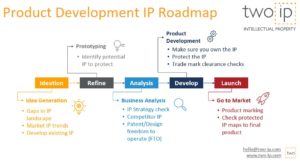
Did you know that companies with intellectual property rights (IPRs) generate 23.8% higher revenue per employee and pay 22% higher wages?
In today’s fast-paced, innovation-driven economy, protecting your ideas isn’t just important – it’s essential. The latest EPO and EUIPO report reveals how owning patents, trademarks, and designs can transform firm performance, especially for SMEs, who see an incredible 44% revenue boost when leveraging IPRs.
Curious about how IPRs fuel growth, attract investment, and secure competitive advantages? Two IP founder Anna Molony shares key learnings from the report.
Owning IPRs significantly enhances the performance of companies, with measurable benefits across financial, operational, and competitive dimensions. The 2025 European Patent Office (EPO) and European Union IP Office (EUIPO) report, “Intellectual Property Rights and Firm Performance in the European Union,” provides a comprehensive analysis of how IPR ownership translates into tangible advantages for businesses – these are the key points for SMEs.
Higher Revenue per Employee
Companies with IPR ownership generate, on average, 23.8% more revenue per employee compared to firms without IPRs. This is because IPRs allow companies to create unique, high-value offerings that command premium prices in the marketplace. Protected innovations ensure that competitors cannot replicate these offerings, enabling companies to maintain strong pricing power and brand equity.
Increased Wages and Talent Retention
IPR-owning firms pay 22% higher wages on average than non-IPR-owning firms. This is indicative of their stronger financial health and higher productivity levels, as well as their ability to attract and retain top-tier talent. By investing in innovation and protecting the outcomes, these companies create high-value roles that demand specialised skills, leading to better compensation for employees.
Stronger Performance Among SMEs
While IPRs are beneficial to firms of all sizes, their impact is particularly pronounced for small and medium-sized enterprises (SMEs). According to the report, SMEs with IPRs generate 44% higher revenue per employee than SMEs without them. For these businesses, owning IPRs is often a crucial differentiator, enabling them to compete with larger firms by carving out a unique market niche.
Resilience and Market Positioning
IPR-owning companies exhibit greater resilience during economic downturns and disruptions. By leveraging their protected intellectual assets, these firms can adapt more quickly to changing market conditions, introduce new products or services, and secure their market share. Trademarks, in particular, help build long-term customer loyalty, while patents and designs protect competitive advantages in product innovation.
Access to Investment and Financing
IPRs play an important role in enhancing a company’s attractiveness to investors and lenders. Firms with registered patents, trademarks, or designs are often perceived as lower-risk investments, as their protected innovations can serve as valuable assets that generate future income. For SMEs, the presence of IPRs often improves access to venture capital and other financing sources, enabling them to scale their operations more effectively.
Sector-Specific Insights
Industries such as technology, pharmaceuticals, and creative arts see the most substantial benefits from IPRs, as these sectors rely heavily on innovation and unique intellectual assets. For example, technology firms with patents have a significant edge in securing partnerships and licensing agreements, while companies in the fashion and design industries leverage design rights to safeguard their brand identity and product aesthetics.
Innovation Spillover Effects
IPR ownership not only benefits the individual firm but also contributes to broader economic growth. The protection of intellectual property encourages investment in research and development (R&D), leading to the creation of cutting-edge technologies and products. These innovations often have spillover effects, benefiting other firms and industries through collaborations, licensing, and the general diffusion of knowledge.
Reduction in Counterfeiting and Infringement
By obtaining IPRs, companies can more effectively combat counterfeiting and infringement, which are particularly damaging to brand reputation and revenues. The report emphasises the economic benefits of reducing counterfeit goods, as IPRs provide companies with legal tools to enforce their rights and take action against infringers.
💡 What are you doing to protect your IPRs?
IPRs not only offer protection but are also a strategic asset that drives performance, competitiveness, and growth. For innovative companies, particularly SMEs, IPRs are instrumental in maximizing market potential and securing financial investment.
What steps are you taking to safeguard your business’s creativity and innovation?
Our patent and trade mark attorneys can help you work out what you should be doing and then help you do it. To get in touch, click here or email us at hello@two-ip.com.
💡Found this information useful? Click here to sign up for our monthly Two Insights newsletter.





